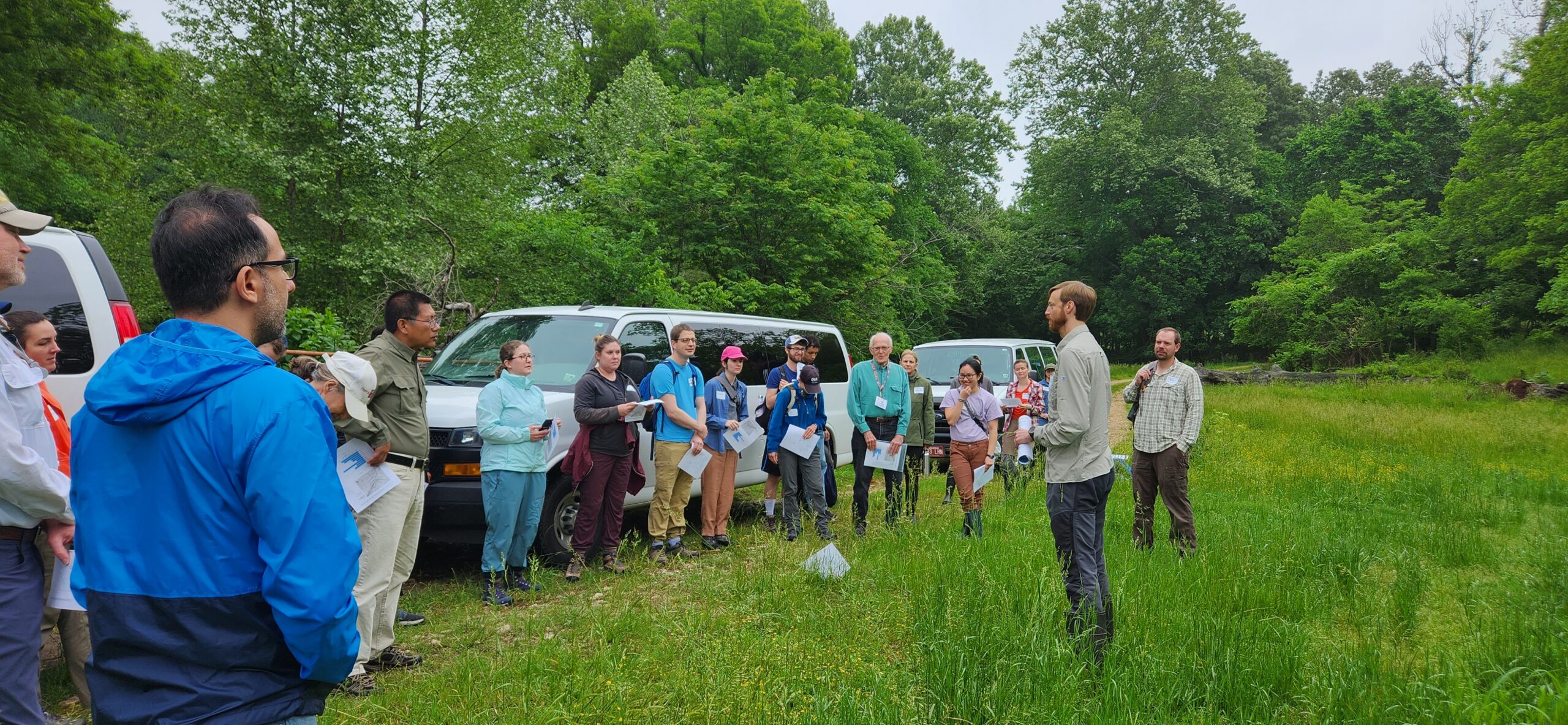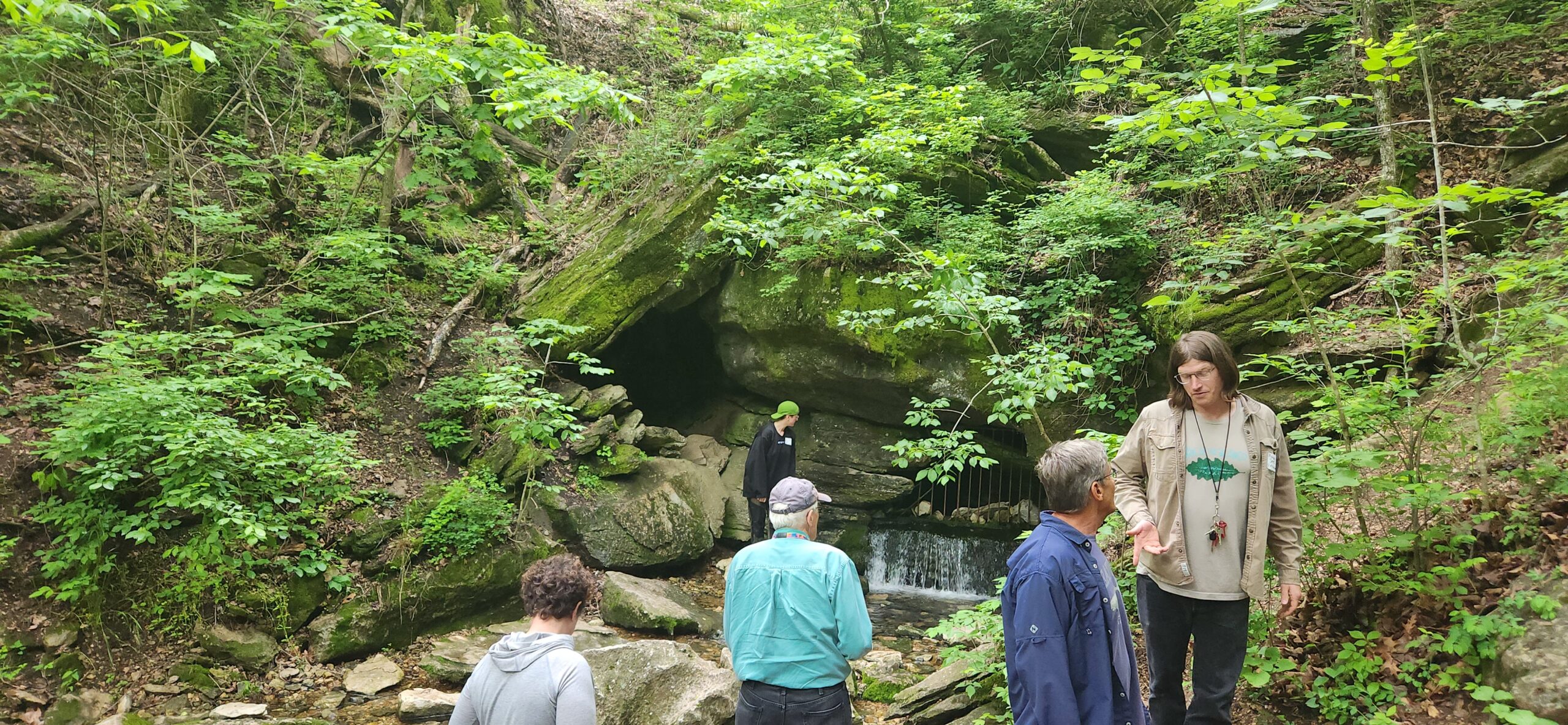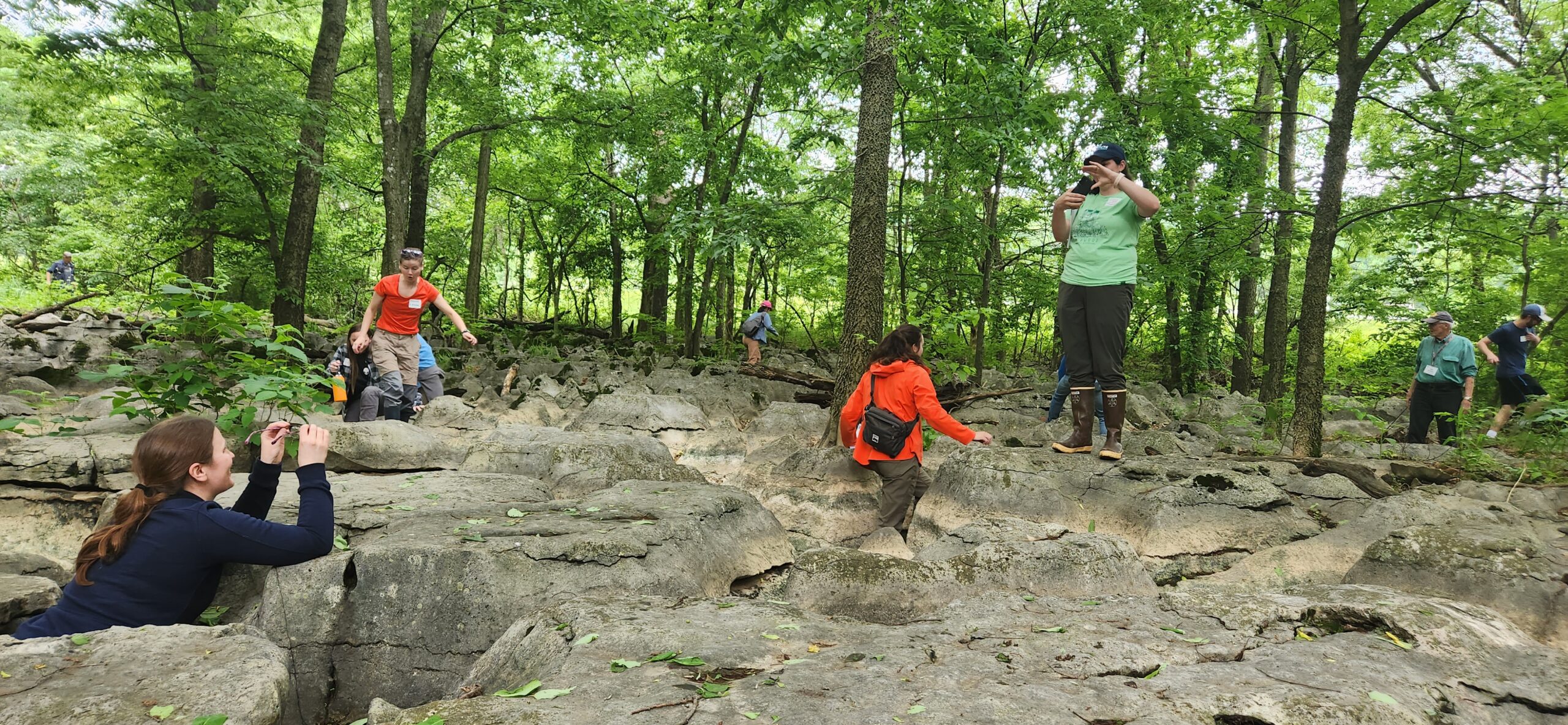Fayetteville, Arkansas, May 16- 19, 2023
Workshop Objectives
This third and final Field Workshop provided a space for the Working Groups to advance the compilation and analysis of legacy datasets and the development of review papers and other outputs. It also provided meaningful mentoring and networking opportunities for members of the Network community as well as for students attending the pre-workshop training session. Prospects for future collaborations after the end of the RCN were discussed.
Workshop Participants
The workshop was attended by 22 participants from across 14 institutions. Participants included undergraduate and graduate students, Post Doctoral Associates, faculty from diverse career levels, and scientists from governmental agencies who represented a range of disciplines: geology, hydrology, ecology, microbiology, ethnoecology, geochemistry, sustainability, and others.
Workshop Achievements
The Biogeochemistry working group developed two specific science questions that the members of the group plan to address over the final year of the RCN. Both questions relate to changes in biogeochemical reactions across two gradients including the silicate-carbonate mineral continuum and salinity. The questions are: (1) What are the magnitudes of redox gradients within the carbonate critical zone and their impacts on biogeochemical reaction products such as nutrient concentrations, greenhouse gas production and consumption, and trace metal cycling and (2) What are the impacts of variations in organic carbon loading to the carbonate critical zone particularly related to energy transport through the carbonate critical zone? These questions will be addressed through compilation, syntheses, and analyses of legacy data depending on their availability at targeted locations. Locations were chosen based on differing salinity and lithological characteristics and where WG members had prior knowledge of the region.
The Rates and Time Working Group developed two related hypotheses. These include: (1) The relative contributions of matrix and conduit flow are influenced by the type of karst. High frequency nitrate data from contrasting karst types in Florida and Missouri are being examined using discharge hysteresis plots. (2) When carbonate systems respond to land use and climate change, a threshold exists where transport, weathering, and related processes are faster in carbonate systems compared with silicate-dominated systems. The second hypothesis focused much of the Working Group activities over the past year and included collecting, synthesizing, and evaluated 50-year discharge data from 36 European springs and 30 to 50-year nitrate concentration data from 11 US springs. The discharge data were classified by their variability and compared with surrounding land use. Both increasing nitrate concentration and stable concentrations were observed in each karst region but the data did not show a distinct pattern with karst type, which might have been expected if storage was a key factor. One of the lessons learned, which may be the focus of a future paper, is that long-term time series data are sparse but necessary for cross site comparisons.
The Boundaries and Scales Working Group switched their focus from their original question of what controls the bottom boundary of the carbonate critical zone to one related to the location of erosion within the carbonate critical zone. The primary question this group plans to address is: What controls the partitioning of erosional fluxes between flow across the surface compared with flow through karst conduits? Multiple potential variables that may control the flux including: climate (temperature, precipitation, PET), rock properties across the carbonate-silicate spectrum (silicate content and distribution), permeability/porosity, tectonic setting (relief/slope), soil type, and land use/vegetation. An evaluation of this problem will use the karstification index, which is derived from the fraction of landscape that drains into sinkholes. This index will be calculated from LIDAR derived land surface DEMs and two published data sets of sinkhole distribution in the US.
All working groups have been and will continue to use available legacy data and the ad hoc data committee focuses on archiving the data synthesis. To that end, the group has created and are continuing to develop a public Group called “Carbonate Critical Zone RCN” on Hydroshare that will be a repository for compiled data sets related to the carbonate critical zone. The Hydroshare site is supplemented by the RCN website and both sites have information that includes Collab notebooks, field trip videos, GIS files, and instructions on using Hydroshare.
Workshop Structure and Activities
May 16: Networking meet and greet
This meet and greet aimed to foster networking opportunities for the students that participated in the pre-workshop training on Critical Zone Science, as well as students attending the workshop.
May 17: Field trip
Welcome and introduction to workshop
Field trip
Stop 1: Savoy Experimental Watershed: The Savoy Experimental Watershed (SEW) is a collaborative Research Site for the Study of Animal Waste Management in Mantled Karst Terrains. The main goal of (SEW) is to establish and maintain a long-term research site for comprehensive, multidisciplinary research of animal waste impacts on surface and subsurface water quality and hydrogeology. The SEW has been operational since 1996, and has a discontinuous but meaningful record of hydrologic, water quality, geologic, and soil characterization studies completed. SEW has served primarily as an applied field-training site and education and outreach center, with an impressive array of infrastructure, studies, and understanding gained from field camps, training courses, field trips, and thesis and dissertation research projects
Stop 2: Blowing Springs: Blowing Springs is one of the larger springs and caves in the Bella Vista area. The spring emerges from the St. Joe Limestone. The cave is a branchwork stream cave and the passages are controlled by a mix of bedding partings and joints. The cave displays a regular pattern of chimney effect airflow with cool air blowing out of the cave entrance in the summer and cold winter air being sucked in the entrance in winter. This site has undergone extensive study over the past 15 years, with studies focusing on contaminant transport, CO2 dynamics, and stable isotopes
Stop 3: Crystal Lake: The soil and regolith cover has been removed by erosion from the overflow at Crystal Lake, exposing a subsoil karstification at the top of the St. Joe Formation (Pierson Member). The nearly orthogonal joints direct flow during times of high water, and debris in the enlarging flow passages creates a remarkably variable water level. A spring resurges from the base of the Pierson, and a well washed surface of the underlying Northview Member (shale facies) is visible. The regional confining unit, the Chattanooga Shale, is visible lower in the valley of Wolf Creek. Upstream, and behind the dam, the cherty facies of the lower Boone Formation can be seen in the far bluffs.
Stop 4: Cave Springs: Cave Springs Cave contains one of the largest known populations of the Ozark Blind Cavefish, which is an endangered species. This site is managed by the Arkansas Natural Heritage Commission and the Illinois River Watershed Partnership. The recharge area for the cave has undergone increasing development over the last 30 years. However, the presence of the cave fish has influenced both the location of Highway 540 and Northwest Arkansas Regional Airport.
Dinner Banquet
May 18: Advancing working groups goals
Working group presentations: Each working group presented their goals, expected outcomes, progress and plans for the workshop.
The future of CZ science or integrated science at NSF: Richard Yuretich, NSF Program Director presented an overview of of the CZ science under NSF and provided a list of current NSF funding opportunities where proposals focusing on CZ can be submitted.
Working group sessions: Working groups broke into breakouts to continue discussions and data gathering
Guest speaker Plenary Presentation: Jill Marshall, Assistant Professor Surface Processes, Critical Zone Science, Department of Geosciences, University of Arkansas (Subcritically) cracking the critical zone- when Earth, wind, water, and trees intersect
May 19: Closing working groups and next steps
Working group sessions: Working groups broke into sessions to continue discussions and data gathering
Plenary: Working Groups reporting and cross pollination discussions. Discussion on RCN timeline, expected outcomes, funding opportunities, next steps




